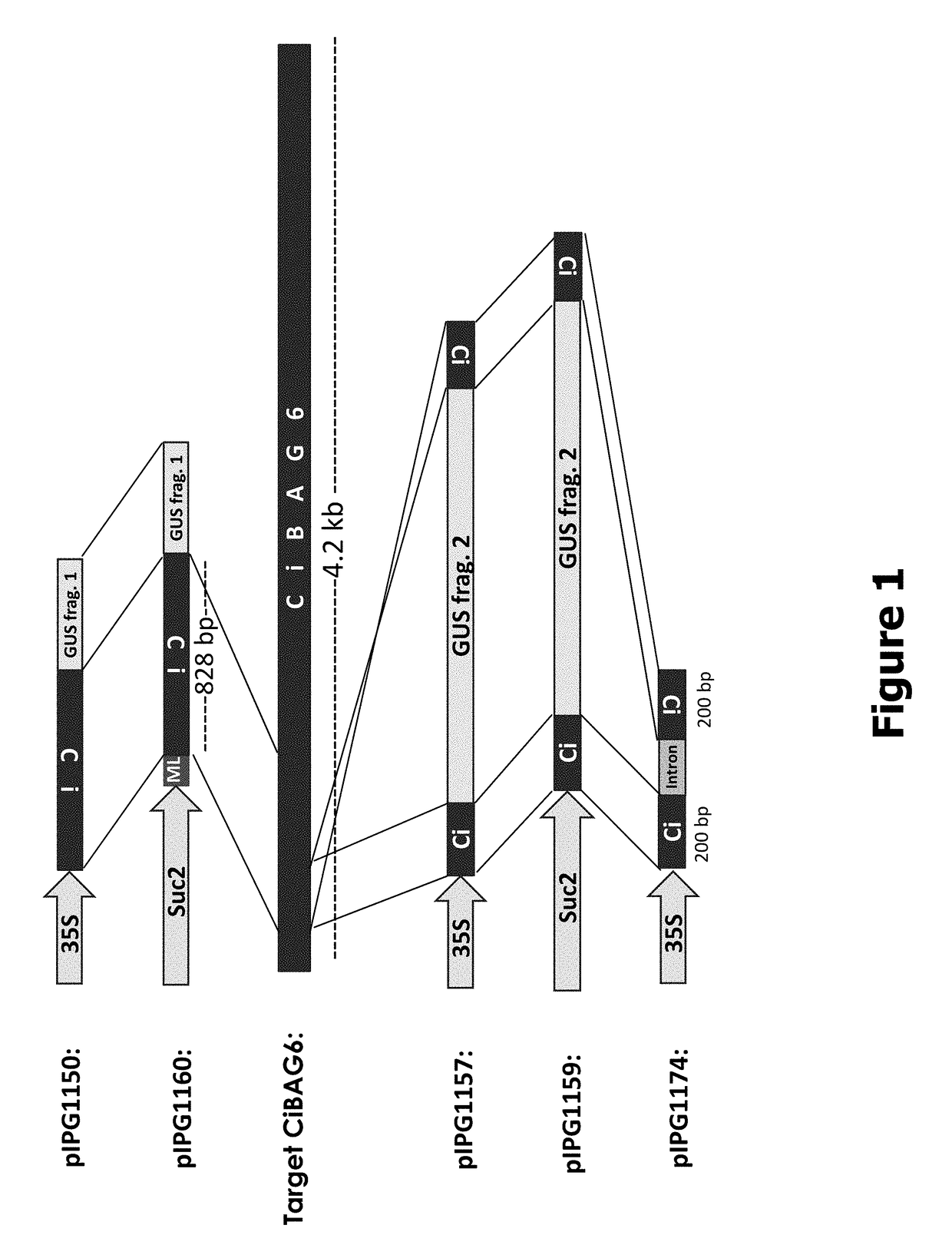Methods and compositions for preventing or reducing infections of crop plants by bacterial and fungal pathogens
- Summary
- Abstract
- Description
- Claims
- Application Information
AI Technical Summary
Benefits of technology
Problems solved by technology
Method used
Image
Examples
example 1
ation of Citrus CiBAG6 Homolog and Demonstration of Single Identical Homologs in Carrizo, Hamlin and Valencia
[0100]BLAST-P searches were performed using the predicted AtBAG6 protein sequence to identify a single citrus locus within the Clementine genome available online (http: / / www.phytozome.net / ), referred to herein as CiBag6 (clementine0.9_012925m, coding region included in SEQ ID NO: 8). The DNA sequence of this locus, which is an AtBag6 homolog, was then used to determine how closely related it might be to other members of the Bag6 gene family in Clementine or Sweet Orange. Neither Clementine nor Sweet Orange varieties Hamlin or Valencia appeared to have any other sequences with high sequence similarity (>50%) over a stretch of more than 18 base pairs to AtBag6, other than a single CiBag6. This demonstrated not only that citrus did not carry multiple Bag6 homologs, but also that any region on CiBAG6 chosen as a probe or for silencing purposes would likely be specific to the targ...
example 2
RNA (aRNA) Constructs with CaMV Promoter
[0101]The 828 bp region of Carrizo CiBAG6 (SEQ ID NO: 1) from the ATG start codon to the coding end of the fragment (position 103-930 of SEQ ID NO: 1) was cloned in the antisense direction into pIPG973 (WO 2013 / 032985 A1), which carries a single CaMV promoter. The CiBAG6 antisense fragment was then transcriptionally fused with 516 bp (in the sense orientation) from the uidA gene from pCAMBIA2301, forming pIPG1150 (see Table 2 and FIG. 1; SEQ ID NO: 2). This clone was used to transform Carrizo seedlings, resulting in multiple transformation events confirmed by PCR. Each transgenic event was numbered and expression of the CiBAG6 antisense construct was confirmed by rtPCR, using RNA extracted from each confirmed transgenic Carrizo event. Each confirmed expressing transgenic event was then evaluated to determine if CiBAG6 in Carrizo was actually silenced or not. DNA primers were designed based on the CiBAG6 transcript (cDNA) sequence, but outside ...
example 3
RNA (aRNA) Constructs with AtSuc2 Promoter
[0104]As in Example 2, the 828 bp region of Carrizo CiBAG6 (SEQ ID NO: 1) from the ATG start codon to the coding end of the fragment (position 103-930 of SEQ ID NO: 1) was cloned in the antisense direction into pIPG980 (WO 2013 / 032985 A1), which carries a single CaMV promoter, forming pIPG1160 (see Table 2 and FIG. 1; SEQ ID NO: 3). A potential movement leader sequence from Arabidopsis thaliana, flowering locus T (FT) from nucleotide position 326 to nucleotide 429 in GenBank: GQ395494.1 (SEQ ID NO: 7) was transcriptionally fused in the sense orientation at the 5′ end of the aRNA construct utilized in construction of pIPG1160 (FIG. 1).
[0105]As provided in Example 2, each transgenic event was confirmed by PCR and expression of the CiBAG6 antisense construct was confirmed by rtPCR, using RNA extracted from each confirmed transgenic Carrizo event. Each confirmed expressing transgenic event was then evaluated to determine if CiBAG6 in Carrizo was...
PUM
 Login to View More
Login to View More Abstract
Description
Claims
Application Information
 Login to View More
Login to View More - R&D
- Intellectual Property
- Life Sciences
- Materials
- Tech Scout
- Unparalleled Data Quality
- Higher Quality Content
- 60% Fewer Hallucinations
Browse by: Latest US Patents, China's latest patents, Technical Efficacy Thesaurus, Application Domain, Technology Topic, Popular Technical Reports.
© 2025 PatSnap. All rights reserved.Legal|Privacy policy|Modern Slavery Act Transparency Statement|Sitemap|About US| Contact US: help@patsnap.com



